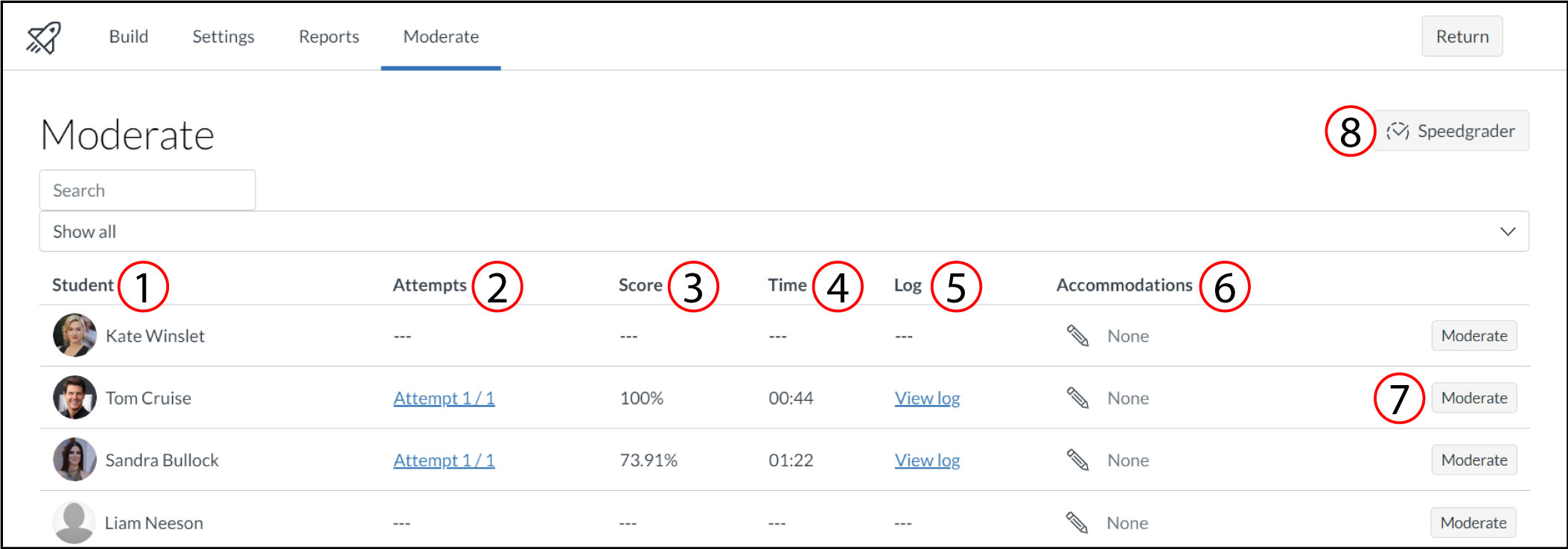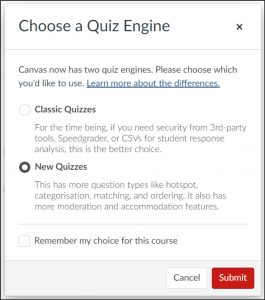
Canvas New Quizzes: Getting Started
New Quizzes is an advanced assessment tool integrated within Canvas. It is designed to provide you with a more robust and flexible way to create and deliver assessments to students. New Quizzes offers a range of features and question types that go beyond the traditional assessment options available in Canvas Classic Quizzes.
This guide provides an overview of the new features, question types, potential pitfalls, and additional information related to Canvas New Quizzes.
Looking at New Quizzes
The New Quizzes assessment tool can be split into 4 main tabs – Build, Settings, Reports and Moderate.
The Build tab allows you to add the title of your quiz and any instructions you might have. You will mainly use the Build tab to populate your quiz [1] with the different question types available. Here, you can view your item banks [2], align the quiz to outcomes [3], preview the quiz from the student view [4], and navigate the quiz [5].
You can use the Rich Content Editor to format and add content to your quiz instructions.

You can adjust delivery settings for a quiz in New Quizzes. These options adjust the way that a quiz is delivered to students.
Settings are mostly the same as classic quizzes but with a few additions. You can require a waiting period between student attempts, shuffle questions globally and shuffle answers per question.

You can view reports for a quiz created in New Quizzes. The reports available in New Quizzes are the Quiz and Item Analysis and the Outcomes Analysis. The Quiz and Item Analysis report includes statistics for the entire quiz and individual items, such as:
- High Score [1]: displays highest percentage score
- Low Score [2]: displays lowest percentage score
- Mean Score [3]: displays average percentage score
- Standard Deviation [4]: represents the amount of variation from the mean score
- Mean Elapsed Time [5]: displays average time to complete quiz
- Cronbach’s Alpha [6]: measures internal consistency of how closely related a set of items are as a group
It may take up to 48 hours for quiz information to display in New Quizzes reports.

You can view student results for any quiz created in New Quizzes on the Moderation page. Quiz results also include a detailed log for each student.
The Moderation Page displays a list of students in the course [1], their quiz attempts [2], the score for each attempt [3], the time for each attempt [4], attempt logs [5], and quiz accommodations [6].
To moderate a quiz for an individual student, click the Moderate button [7]. Moderation options include managing timer settings and reopening a student's most recent attempt.
To open SpeedGrader, click the SpeedGrader button [8].

New Question Types
With New Quizzes, you will have access to all the questions types Classic Quizzes has to offer, along with 4 new question types.
Categorization questions require students to place answers in the correct categories while ignoring all distractors.
When Categorization questions are graded, students must categorize all items correctly to earn full points. There is not an option to assign partial credit for Categorization questions.

In an Ordering question, students are required to place answers in a specific order. You can add top and bottom labels to the list to help students know in which order they should place their responses.
When Ordering questions are graded, students must order all items correctly to earn full points. There is not an option to assign partial credit for Ordering questions.

Hot Spot questions allow you to upload images and have your students identify a specific area in that image.
The following image types can be used for Hot Spot questions:
- BMP
- GIF
- JPG/JPEG
- PNG

⚠ Hot spot questions are not accessible for users who require keyboard-only access or screen readers.
When creating a quiz, you can insert stimulus content in New Quizzes. Stimulus content gives students a piece of content with associated questions.

⚠ Note: You can add stimulus content to an item bank. However, questions attached to the stimulus content are not automatically added to the item bank and must be added manually.
Tips and Tricks
- The New Quizzes Feature Comparison show the current functionality available in New Quizzes compared to the functionality in Classic Quizzes.
- Identify a classic quiz from New Quizzes in a course. The easiest way is if the rocket icon is an outline or filled as shown below:

- You can easily migrate a classic quiz to a New Quizzes format. You can only do this one quiz at a time.
- Time accommodations can be applied to New Quizzes for individual students. You have the ability to apply these time adjustments to one New Quiz, or for all New Quizzes in a single course for an individual student.
- New Quizzes allows you to print assessments and save them as pdf files. This guide details the options for printing New Quizzes.
- Some question types allow you to assign partial points/credit. These include Multiple Answer and Matching. You can also award partial points/credit through SpeedGrader.
Potential Pitfalls
- There may be an issue with migrating embedded media files as they might not always migrate properly into New Quizzes and users can receive an ‘Access Denied’ message. Instructure are working on a solution but have no timeframe.
- Migrating the Classic quiz ‘Text (no question)’ question type to New Quizzes converts it to a ‘Stimulus’ question. If no question is attached to the ‘Stimulus’ question type, it will not appear for a student.
- When using the quiz ‘Export’ option to export and import a New Quiz, the quiz can occasionally import to the new course with a different points value e.g. 100 points to 1 point.
- When copying a quiz using the ‘Copy to’ feature, a spinning icon can appear beside the copied quiz, and this icon can continue to show even when the quiz has fully copied over.
- There may be issues when migrating images from a Classic Quiz Question Bank to a New Quiz Item Bank.
- It is only possible to migrate a Question Bank when it has been attached to a Classic Quiz. This can be done through either a ‘Question group with Inline questions’ or through a ‘Question group linked to a Question Bank’.
- When using the ‘QTI Export option’ to import a quiz, the question bank may not migrate over as expected.
- When editing a shared Item Bank, the edits will be visible everywhere the Item Bank has been shared, including the original Item Bank.
- If a user deletes an Item Bank from the ‘Shared with this course’ or the ‘This course’ list, it will delete for all users who are able to access it from that course.
- New Quizzes anonymity features are still in development. The Canvas Product Roadmap confirms that this feature is in development for Quarters 3 and 4 of 2023 and more information on this should be released by Instructure in due course.
- Graded rubrics should not be used with Quizzes as the quiz is marked by Question rather than through a Rubric. When graded Rubrics are attached to a quiz, students can see the grades which could cause confusion if the rubric grade does not match the quiz grade.
- The ‘Hotspot’ question type may not be fully accessible, as screen readers have an inability to read an image and provide directions on where items on the image are located.
- When you create a quiz, a pop-up window will appear prompting you to pick a quizzing tool. From here, you can select to remember one type of quizzing tool for the course. Make sure to keep ‘Remember my choice for this course’ unselected, otherwise the choice to choose Classic or New Quizzes will not appear again.

- New Quizzes do not allow you to practice quizzes, ungraded quizzes or create surveys. An alternative is to create a New Quiz worth 0 points and select the option to exclude from the final grade if appropriate.





